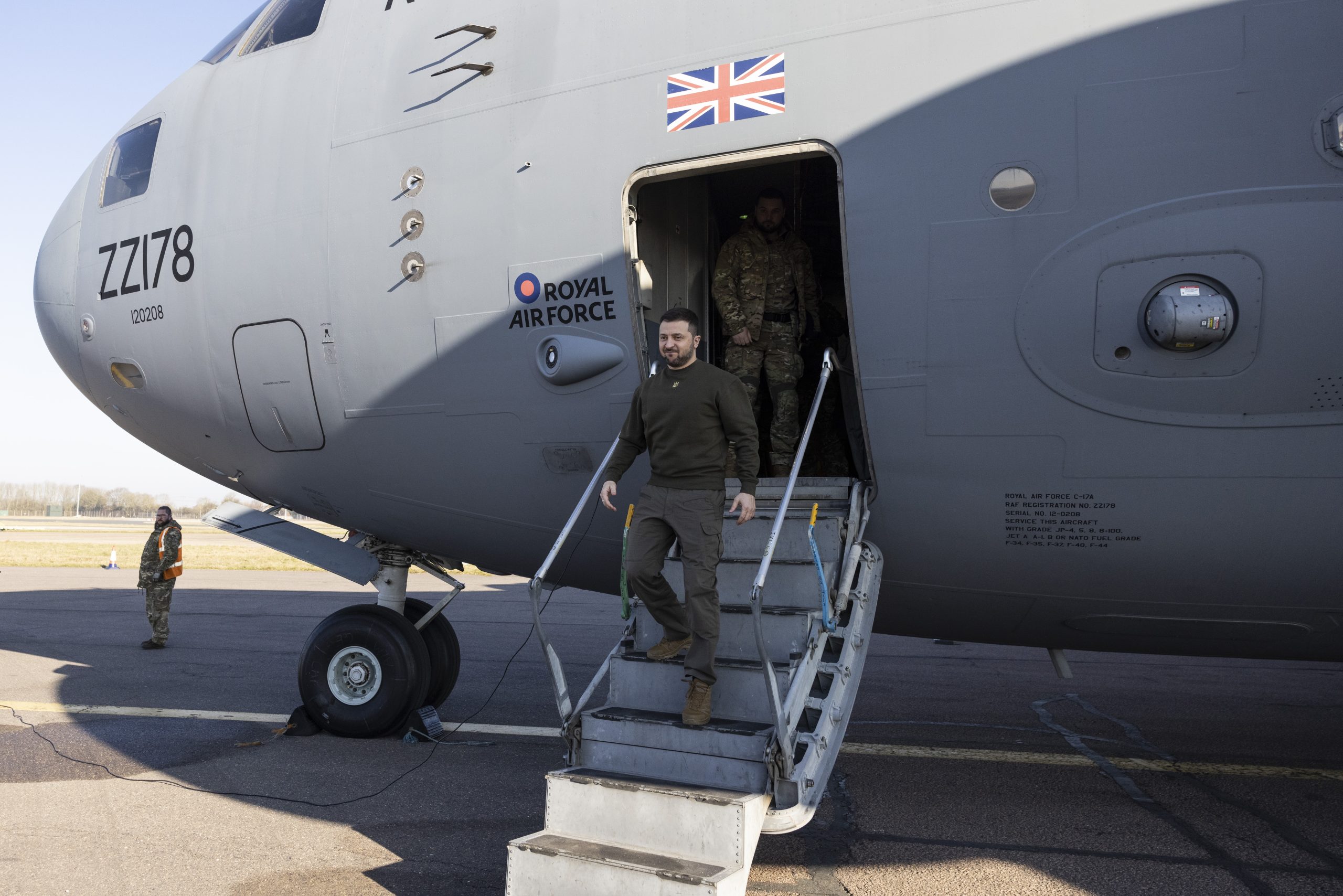Ukrainian President Volodymyr Zelensky used a surprise visit to the United Kingdom on 8 February 2023 to urge the UK to supply fighter jets to Ukraine to repel the Russian invasion there.
During a widely applauded speech to the UK House of Commons President Zelensky presented Sir Lindsay Hoyle, the House of Commons Speaker, with the helmet of a Ukrainian pilot on which was written ‘We have freedom, give us wings to protect it.’
However, although UK Prime Minister Rishi Sunak responded that “nothing is off the table”, and the UK had already that day committed to start training Ukrainian pilots on NATO-standard jets, supplying Ukraine with fighters remains problematic.
UK Defence Minister James Heappey noted to the House of Commons Defence Committee in October 2022 that it takes the Royal Air Force (RAF) 4.8 years on average to train a UK fast jet pilot to the point of joining an operational conversion unit. This has contributed to the RAF suffering a significant backlog in training its own pilots, let alone any from Ukraine.
Then there is the problem of what fast jets the UK could actually supply. Most obviously the RAF is unlikely to give up any of its growing fleet of fifth-generation F-35B Joint Strike Fighters – even if the United States sanctioned that, which is unlikely.
Apart from the F-35s the RAF operates a fast jet combat fleet consisting of 119 Eurofighter Typhoons (including conversion trainers), although in March 2021 the UK Ministry of Defence (MoD) announced plans to retire its older Tranche 1 Typhoons in 2025, since it is deemed not economically viable to upgrade them. At this point the RAF had 30 Tranche 1 Typhoons remaining in frontline service. While these might be considered for Ukraine, adding a new fast jet type to the inventory of the Ukrainian Air Force (Povitryani Syly Ukrayiny – PSU) would bring with it significant logistics and support issues: a dilemma already being faced by the Ukrainian armed forces.
For example, the UK MoD’s undertaking in mid-January 2023 to supply Ukraine with 14 Challenger 2 main battle tanks (MBTs) as part of a package that also included around 30 AS90 self-propelled guns is itself problematic; the Challenger 2 is the only major MBT that still uses a rifled 120 mm main gun and thus requires different ammunition to the 120 mm-armed Leopard 2 and M1 Abrams MBTs pledged to Ukraine by its Western allies.
Before the Russian invasion of Ukraine on 24 February 2022 the PSU operated a fast jet combat air fleet of about 132 aircraft, although estimates of numbers in service varied very widely, reflecting significant numbers of stored airframes.
This total included MiG-29 fighters (36-51 in use of about 100, including 10 MiG-29UBs), Su-24 attack aircraft (12-24), Su-25 close air support aircraft (17-33 including two-seaters) and Su-27 fighters (26-42, plus six two-seat Su-27UB conversion trainers). These aircraft were supported by a training fleet that included 30-47 Aero L-39C advanced jet trainer/light attack aircraft.
However, as of February 2023 the PSU had lost at least 53 frontline combat aircraft according to the Oryx website, which tracks equipment losses in the Ukraine conflict that are confirmed by photo- or videographic evidence; actual losses can be expected to be higher.
Contributing aircraft types to Ukraine with which the PSU is already familiar would much more effectively bolster its airpower over the short term as well as minimising any training and logistics issues. This could possibly be effected by the UK engaging with allies that still operate those types in deals that might involve backfilling those air forces’ fleets.
That said, Downing Street stated on 8 February that UK Defence Secretary Ben Wallace was investigating what aircraft the UK could potentially offer, although it was emphasised that this was a “long-term solution”.
Peter Felstead







![Skybound scanners: Rebuilding Europe’s airborne SIGINT fleet The RC-135V/W Rivet Joint is perhaps the most recognisable Western SIGINT aircraft. The aircraft’s comprehensive array of COMINT DF antenna is clearly visible beneath the fuselage, while the distinctive ‘chipmunk cheeks’ at the forward fuselage contain its ‘Automatic Electronic Emitter Locator System’ (AEELS). [Luca Chadwick]](https://euro-sd.com/wp-content/uploads/2025/06/1-Kopie-218x150.jpg)
![How much ‘growth’ is there still in 4th-Gen fighters? A German Air Force Eurofighter Typhoon flies through the sky during the Exercise BAANA 2024, Ranua, Finland, on 4 September 2024. [US Army/Sgt Scyrrus Corregidor]](https://euro-sd.com/wp-content/uploads/2025/06/Eurofighter-Typhoon-BAANA_US-ArmySgt-Scyrrus-Corregidor-Kopie-218x150.jpg)
![Connect-4 The European Super RAP developed by NATO’s ACCS is shared with NATO’s Allied Air Command headquarters in Ramstein, western Germany. Two CAOCS, controlling NATO airspace above northern and southern Europe, generate these RAPs. [NATO]](https://euro-sd.com/wp-content/uploads/2025/06/NATO-Allied-Air-Command-NATO-Kopie-218x150.jpg)

![Emerging military alliances in the Western Balkans: A redrawing of the regional security map : Signing of Declaration on Military Cooperation between Defence Ministers of Albania, Croatia and Kosovo, in Tirana, on 18 March 2025. [Croatian MoD]](https://euro-sd.com/wp-content/uploads/2025/06/Adriatic-Bloc-signing-ceremony_Croatian-MoD-Kopie-218x150.jpg)
